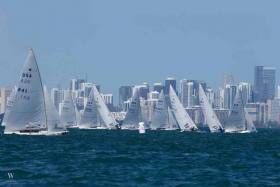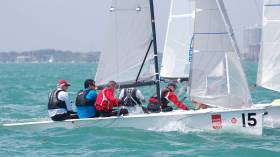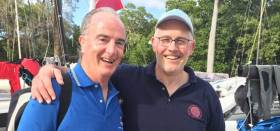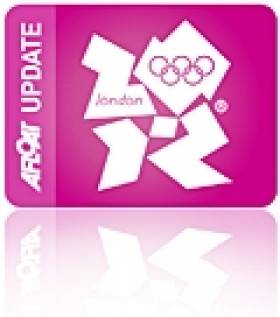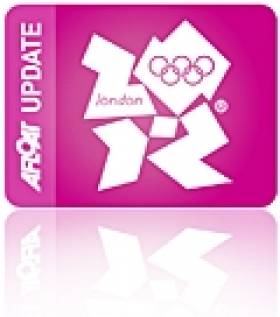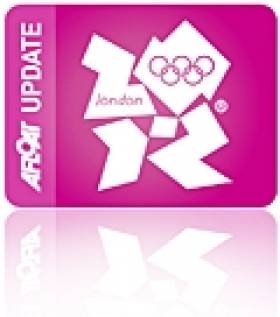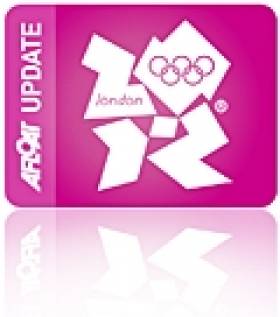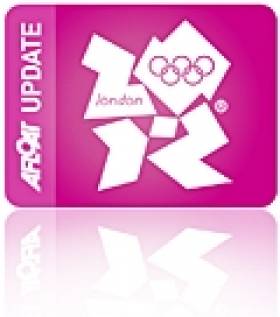Displaying items by tag: Bacardi Cup
In what might be the first competitive meeting since the controversial 2008 Olympic Star selection trials – that ended up in front of an Olympic Council of Ireland Appeal hearing – two of Ireland's 2008 keelboat campaigners Peter O'Leary of Baltimore and Royal Cork and Max Treacy of the Royal St. George Yacht Club are back on–the–water and contesting this week's 2018 Bacardi Cup in Miami.
The Cup is one of the oldest and most traditional sailing events in the world. What started out as a three-day event with less than 10 boats in 1927, now attracts more than 200 sailors each year from some 23 countries and the attention of international media. It is is legendary as one of the few sporting events in which weekend enthusiasts have the opportunity to compete head on with Olympian and World Champion athletes.
As long time Afloat.ie readers will be aware, it was O'Leary who went on to represent Ireland in Beijing in 2008. A decade on, and now sailing with new crew, brother Robert, the Cork Harbour ace has taken first advantage yesterday and is placed sixth in the 76–boat fleet while Dublin Bay's Treacy, sailing with 2008 partner Anthony Shanks, is six places behind in 12th overall after one race sailed.
In his new Star boat, named Dafni, O'Leary – who also sailed at London 2012 – is already very much up to speed winning last month's Star Walker Cup at the same venue. It was a result that earned them a February 2018 Afloat.ie Sailor of the Month award in to the bargain.
Yesterday, American's Augie Diaz and Bruno Prada, of the USA took the first winners gun on Biscayne Bay, Monday.
They finished ahead of Eivind Melleby and Joshua Revkin of Norway with Diego Negri and Sergio Lambertenghi of Italy in third place.
Paul Cayard and Mark Strube USA finished fourth and fifth were Eric Doyle and Payson Infelise USA, with Ireland's O'Leary brother's sixth.
Top ten after the first race:
1. Augie Diaz / Bruno Prada, USA
2. Eivind Melleby / Joshua Revkin, NOR
3. Diego Negri / Sergio Lambertenghi, ITA
4. Paul Cayard / Mark Strube, USA
5. Eric Doyle / Payson Infelise , USA
6. Peter O'Leary / Robert O'Leary, IRL
7. Robert Scheidt / Brian Fatih, BRA
8. Thomas Allart / Arthur Lopez, NED
9. Peter Vessella / Phil Trinter, USA
10. Luke Lawrence / Pedro Trouche, NED
Full results are here
Royal Cork Viper Trio Eighth in Miami's Bacardi Sailing Week
Cork Harbour's Anthony and Robert O'Leary and Tom Durcan have finished in the top eight of the competitive Viper 640 Bacardi Sailing Week fleet. The overall result brings a successful conclusion to a week of racing in Miami, Florida where the Royal Cork YC trio also finished second in the EFG Winter Cup regatta the previous weekend. O'Leary was pipped for the overall EFG win by Lawrence and Luka Crispin and Hector Cisneros, a British entry that swept the Viper Miami week of sailing.
O'Leary counted six top ten results in the eight race Bacardi Cup, missing seventh place in the 29-boat fleet by just two points.
After turning in a dominating performance for the EFG Winter Cup, Crispin and crew controlled Bacardi Miami Sailing Week Regatta which was also the EFG Viper Pan-American Championship.
By placing well in two Pan-Am qualifiers (the NAs and the Winter Cup) Lawrence, Luka and Hector will also be taking home the Pan-Am Champs as they return to the UK and Stone Sailing Club.
The Viper 640 class is coming to Volvo Cork Week in July.
Meanwhile, for the week that's in it, we very much like the spinnaker on Trey Sheehans' J70 Bacardi Sailing entry from Put-in-Bay Yacht Club, Ohio.
J/70 at BACARDI Miami Sailing Week
Posted by IPHOTOJOURNALIST on Saturday, 12 March 2016
Royal Cork's Viper 640 Second in Winter Cup Regatta
Anthony O'Leary, Robert O'Leary and Tom Durcan were narrowly pipped for an overall win in the Viper 640 EFG Winter Cup Regatta in Miami at the weekend. The Royal Cork trio sailing 'Antix' finished second overall where there were two days of big winds in a 16–boat fleet. O'Leary was beaten by the UK's Lawrence Crispin, third was John Dane, the USA Star 2008 Rep from Beijing.
The Crosshaven helmsman is back on Biscayne Bay tomorrow for the 2016 Bacardi Cup regatta where he finished seventh last year. (Gremlins caused an earlier misreport of the 2015 results). Strong winds are forecast for this week's event.
The Viper 640 sportsboat fleet is coming to Volvo Cork Week this July.
O'Leary Drops to Fifth at Bacardi Cup, Miami
#bacardicup – Now fifth overall in the standings at the 2013 Bacardi Cup in Miami is Irish Olympian Peter O'Leary and Rodney Hagebols who have 13.5 points after finishes of 2.5-36-11.
Breeze just into the double digits made the second day of racing for the Cup a test of experience and persistence for the 56 Star teams racing on Biscayne Bay.
Two races were completed as the sunshine warmed temperatures into the low 70s, and, with three races scored a drop race now comes into play. While Lars Grael and Mario Lagoa (BRA) remain first overall with two points net after adding today's finishes of 12-1 to their win of yesterday's lone race, less than 12 points separate the top-five teams.
Lars Grael and Mario Lagoa (hull 74) are the standings leaders after two days of racing for the 86th BACARDI Cup
"Races were similar to yesterday although the second race overall was more gentle," said Grael. "On the first race today we did a wrong jibe and we rounded the mark fifth, closed the downwind leg 25th and finished 12th; it was a difficult race for us. Second race of the day started well, we rounded the mark first and protected the position. While fighting with Xavier Rohart we managed to keep a good gap with the rest of the field. Overall we're happy because competition is tough and we're competing against Augie Diaz who is a local sailor and I believe has the home advantage."
Diaz, with crew Arnis Baltins, is just three points out of first place and knows winning this championship will come down to more than local knowledge.
"The first race was difficult, but we managed to do well," said Diaz of the win of today's first race. "We had better opportunities and with a little bit of luck we were able to round the weather mark third and then take the lead to the end. Second race of the day was more challenging because we decided to go on the right side of the course while the wind went left; I'm therefore happy with a 10th place. I have a lot of respect for Lars because he is very good in all conditions and in all venues. I don't think I have a big edge by being local; really not as big an edge as he might think I have."
Third overall are the defending champions Xavier Rohart and Pierre Alexis Ponsot (FRA), who placed 6-2 today, a strong recovery from yesterday's finish of 25. They carry eight points and are followed in fourth by the Italian team of Diego Negri and Frithjof Kleen whose scoreline of 13-3-9 totals 12 points. Rounding out fifth in the standings is Irish Olympian Peter O'Leary and Rodney Hagebols who have 13.5 points after finishes of 2.5-36-11.
The Italian team of Diego Negri and Frithjof Kleen are fourth overall with three races scored.
Racing for the Star class resumes tomorrow, Wednesday, March 6. Starting on Thursday, March 7, the Stars will be joined on Biscayne Bay by sailors in the Viper 640, Audi Melges 20, and Melges 24 classes, along with the J/70 class which makes its event debut. Racing, for all classes, will conclude on Saturday, March 9
French Crew Pip O'Leary/Burrows for Bacardi Honours
#BACARDI CUP – Peter O'Leary and David Burrows have been pipped for a second year running by a French team for overall honours in the prestigious Bacardi Cup.
The Irish Olympic pair lost out by three points yesterday but will take consolation in a well earned second overall against some key opponents. They sailled a consistent six race series in their new boat launched just in time for the Miami event. O'Leary steered to five top five placings (including two race wins) only dropping out of the top five once to record an eighth in the opening race.
Reflecting on the result a message on the Irish team's facebook page this morning says: 'Put it in the bitterness bank and move on'.
Six-time Olympian and two-time Star world champ Xavier Rohart of France added a new title to his sailing CV by becoming the winning skipper of the 85th Bacardi Cup on Biscayne Bay.
Rohart and crew Pierre Alexis Ponsot clawed their way through the 63-boat Star fleet to a fourth-place finish in Saturday’s final race — earning a score just low enough to overcome threats from not only the Irish but Polish and Austrian teams that had challenged all week. Full results are here.
Last year in spite of leading the regatta going in to the final race the Cork/Dublin sailors were pipped by a single point for overall honours. On that occasion France's Guillaume Florent and Pascal Rambeau accomplished a rare achievement winning the prestigious regatta at their first attempt.
O'Leary's brother and training partner Nin sailing with Rodny Hadenbols scored 11th overall at their first Star event.
Additional reporting from Miami organisers:
With five races already on the scoreboard, the Star fleet today completed the sixth race for the 85th BACARDI Cup, being held for the 50th year in Miami. Briefly postponed, the final race for the Stars got underway with just seven knots of breeze from the east southeast. The Swiss team of Flavio Marazzi and Enrico De Maria were across the finish line first, followed by Miami's own Augie Diaz with Bruno Prada, and 2008 Star World Champions Mateusz Kusznierewicz and Dominik Zycki (Poland). Xavier Rohart and Pierre-Alexis Ponsot (France) were across fourth, followed by 2008 Olympian Peter O'Leary and David Burrows (Ireland). By finishing ahead of the Irish team, Rohart and Ponsot, who had started the day with a three-point lead on O'Leary and Burrows, maintained the point spread to win the championship title with 13 points. O'Leary and Burrows, with 16 points, and Kusznierewicz and Zycki, with 18 points, filled out the remaining podium spots. Diaz and Prada, with finishes of 11-4-7-5-8-2; 26, moved up to fourth overall, with day one leaders, Austria's five-time Olympian Hans Spitzauer and Gerd Habermueller, finishing fifth overall with 29 points.
"It's wonderful," said Xavier Rohart on winning the 85th BACARDI Cup. "I'm extremely happy for this achievement. It's a dream come true! I've been dreaming about it for 10 years and finally it happened. Unfortunately, I'm on my way to the airport as I have to be back home and I will miss the celebration tonight, but my crew and coach will be there. This concludes my training in Miami and I will continue to focus on more training before the Olympics."
High Winds Scrub Second Day of Racing at Bacardi Cup
#BACARDI CUP – With a large area of high pressure parked over the East Coast of America generating strong easterly winds across the Florida peninsula, organisers of the 85th Bacardi Cup were forced to cancel racing for the second day in a row. Organisers have revised the schedule for the 67 registered Star teams to include a second race today and Friday.
Bacardi Cup Racing Cancelled Due to Strong Winds
#BACARDI CUP – With an east-northeast 29-knot breeze gusting to 35 knots and a prediction for more of the same over the course of the afternoon, organisers of the 85th Bacardi Cup in Miami cancelled the day's scheduled race for the 67 registered Star teams. Two Irish boats are in the fleet including Olympic duo Peter O'Leary and David Burrows. The Stars race alone through Thursday, March 8, after which they will be joined by the Viper 640, Audi Melges 20, Melges 24 and J/80 classes. Racing concludes for all classes on Saturday, March 10.
The sailing season is starting and selecting the Afloat.ie/Irish Independent "Sailors of the Month" for March has been a swift business, with the remarkable performance by Peter O'Leary of Cork and David Burrows of Malahide in the Olympic Star Class's legendary annual Bacardi Cup series in Miami emerging as the clear winner.
Admittedly the Irish duo only managed the runner-up slot in Florida. But in a fleet of 93 boats rampaging around in wildly varying conditions, it was an achievement to be at the top of the frame at all. And they were beaten by only one point, even if it was lost in the final race, which they'd started leading overall by a point.
Because the Stars are under a death sentence in the Olympic scene, with next year's Olympiad their final appearance in the five ring circus, the class has acquired an extra slightly morbid interest. And the boat tuning and tweaking knowledge acquired during their long Olympic career will see the class's measurement and equipment rules pushed to the uttermost for this last hurrah.
In fact, some Star fans have become emotional and compared the showdown to a combination of the OK Corral, the Alamo, and Custer's Last Stand in light of the Star's American origins, while the more internationally and nautically minded have invoked memories of Trafalgar and Lepanto.
And all this for one of the oddest looking and most demanding boats on the planet. The Olympic glow does that to people. This time round, we happily glow ourselves, as the O'Leary-Burrows team (each has figured as Sailor of the Month before, but this is their first time together) and the combinations shows every promise of having what it takes.
Irish Olympic Crews in Top Twenty of World Rankings
Peter O'Leary who has been sailing with three different crews, David Burrows, Frithjof Kleen and Timothy Goodbody to date is ranked 17th by the International Sailing Federation (ISAF).
O'Leary and Burrows sailing in the Star keelboat class were recent top finishers at 93-boat fleet in Miami. They finished second overall after they lost the overall lead in the last race of the 2011 Bacardi Cup.
Listen into a podcast about Peter O'Leary's Olympic sailing plans HERE.
Fellow Olympic squad member, 21-year old Annalise Murphy from Dun Laoghaire is now ranked 12th in the Laser radial class counting seven ISAF events. Murphy has also had success in Florida this season, she finished fourth in the Miami Olympic Classes regatta in January.
Listen to what Team Manager James O'Callaghan has to say about her progress:
The next release of the ISAF World Sailing Rankings will be on 13 April 2011 and will include the Trofeo SAR Princess Sofia Mapfre in Spain.
The ISAF World Sailing Rankings rate skippers based on their performances over the last two years. Skippers score points by competing in ISAF Graded events. The top finishers at all ISAF Graded events score Rankings points, with the highest points awarded to the event winner and then decreasing down relative to position.
More Irish Olympic Sailing News HERE.
O'Leary and Burrows Pipped by Single Point for Bacardi Honours
France's Guillaume Florent and Pascal Rambeau accomplished a rare achievement in Saturday's finale of the 84th event Cup.
Florent, the 2008 Olympic bronze medalist in the Finn class who switched over to Star keelboat last year, won the prestigious regatta at his first attempt.
O'Leary and Burrow's second overall in the 93-boat fleet is being hailed as a major result for the pair who have sights firmly set on selection for the London 2012 Olympic Games.
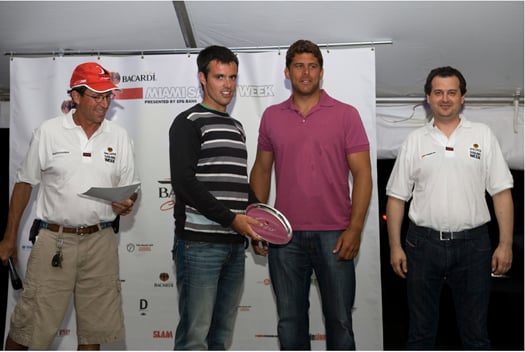
Peter O'Leary and David Burrows (centre) receive the Bacardi Cup second place salver in Miami yesterday. Photo: Courtesy Bacardi Cup/Star Class
Their final score after six races that began on Monday was 24 — only one point behind the French duo.
In a consistent display of speed and tactical ability against a big international fleet only Ireland posted the most consistent scores of the series with all results in the top ten.
Racing in the event was cut short due to thunderstorms on Thursday.
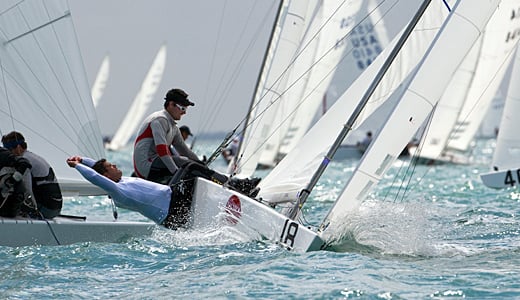
Peter O'Leary with crew David Burrows at full stretch at the weather mark. Photo courtesy Bacardi Cup
O'Leary and Burrows recorded single-digit finishes over the course of the regatta; they finished with an 8-4 on the penultimate day to move from fourth overall into the lead of the 89-boat fleet with 18 points only to lose out in the final race.
Full Results HERE.
Star Class website/results/comment HERE
Photos of O'Leary and Burrows in action on our gallery HERE
Podcast interview and Career highlights of Peter O'Leary HERE


























